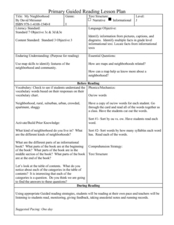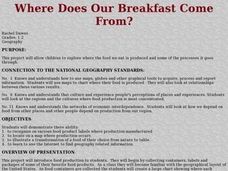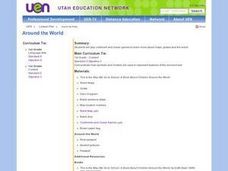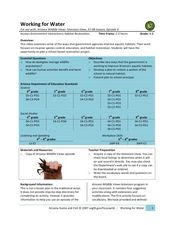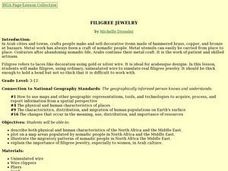Curated OER
My Neighborhood:
Pupils act as tour guides for their communities after conducting research about their neighborhoods. After conducting research, students write stories and create maps of their communities to share with classmates and community members.
Curated OER
Where Does Our Breakfast Come From?
Students bring in the cartons and containers of some of their favorite foods. They locate the origin of these foods on a map and visit a farm to view how food is grown and processed by a farmer. Students read books, complete worksheets...
Curated OER
John Muir in California
Fourth graders listen to key events in John Muir's life and plot locations on a California map. They discover that John Muir was an immigrant to California who encountered environmental problems and found solutions.
Curated OER
Mapmakers' Perspective
Students examine several maps and consider mapmakers' perspective in early depictions of North America.They determine how the spherical shape of the earth makes any north-south and east-west orientation a matter of perspective. For...
Curated OER
Penguins Marching in Your Classroom
Sixth graders examine how penguins adapt to their Antarctic environment. Once they locate Antarctica on a map, they describe its characteristics and differences from other continents. After describing how penguins differ from more...
Curated OER
The Earth, Sun Mood and Stars Unit (Planets too!)
Fifth graders prepare five activities to do then show their energy saving skills. In this investigative lesson students create five projects then participate in an energy saving demonstration.
Curated OER
You Are Uniquely You; Reflecting and Sharing
Students write a letter as a culminating activity to a service project. In this reflection project, students draw something that occurred during the project and attach words to their drawings. Students pair share to edit their work.
Curated OER
Colorado
Third graders complete a variety of activities to increase their knowledge of Colorado. They make leafprints, read and listen to stories, write fiction, make collages, participate in discussions and invite their parents to come and see...
Curated OER
Hawaii
Fourth graders become knowledgeable about Hawaii the state and Hawaii the island. They also work on reading maps of the islands. They come to know the customs, climates and other fun little facts. They also come to know the eight islands.
Curated OER
New: Around the World
First graders identify and demonstrate how symbols and models are used to represent features of the environment. They use a map and a globe to label where the students in the book came from, point out the continent, and show which ocean...
Curated OER
Where Oh Where
Learners read a current event article orally and make connections regarding the geographic themes of the newspaper location. In this current event article lesson, students use a map to locate where the event from their...
Curated OER
Trading Pennies and Dimes
Second graders, while in the computer lab, explore the strategy of making and grouping to ten. They assess how to trade pennies for dimes and create original word problems along with corresponding number sentences to illustrate grouping...
Curated OER
Human Footprint
Students study facts about humans and how they are impacting the Earth. In this investigative lesson plan students help map peoples footprints over the Earth's surface and evaluate these factors.
Curated OER
Crater Lakes and the Volcanoes of the Cascade Mountains
Students study volcanoes. For this Earth science lesson plan, students read, discuss and take notes on the volcanoes of the Cascade Mountains. This lesson also includes an art project.
Project SMART
Rocks and Minerals: Touch the Earth
Students complete a unit of lessons on rocks and minerals. They conduct research, write e-mail questions to geologists, write daily journal entries, label maps demonstrating types of rocks/minerals found, and create a web page that...
Curated OER
Greece: The Landscape
Students work in small groups to create a topographic map of Greece. They must include labeled line drawings of bordering countries and bodies of water. Students use salt and flour clay to make Greece three dimensional, showing the many...
Curated OER
Hurricane Influence: Landfall Probabilities and Wind Speed
In this earth science worksheet, students study a hurricane map and answer 7 multiple choice question about it. They calculate the wind speed on different areas of the map.
Curated OER
Working for Water
Students examine the ways that government works to help improve aquatic habitats. In this water habitats lesson students view a video and plan a school restoration project.
Curated OER
Primary History Ancient Greeks Extension Activity: Arts and Theatre
In this primary history worksheet, students sharpen their research skills as they study the arts and theatre of ancient Greeks. Students select 1, 2, 3, or 4 extension projects to complete
Curated OER
Life Beyond the Fifty Yard Line -- An ecological look at our backyard
Students, in groups, stake out and rope off their study area, do population counts and density studies. They construct a map of the whole area, collect plants and insects, and mount and identify the organisms using keys.
Curated OER
MathKeys Software "Unlocking Whole Numbers, Vol 2 (Rolling the Highest Number)"
Third graders arrange four numbers in order to make the highest number possible. In this place value lesson plan, 3rd graders practice working with four digit numbers on the computer and with base ten blocks.
Curated OER
Geography of the Roman Empire
Students explore the Roman Empire. In this ancient Rome lesson, students research regions of the Roman Empire and present their finding to their classmates. Students also use an interactive map to practice placement of the regions within...
Curated OER
Filigree Jewelry
Young scholars describe physical and human characteristics of North Africa and the Middle East, plot on a map areas populated by nomadic people in those areas, explain importance of filigree jewelry in Arab culture, and create their own...
Curated OER
The Seminoles
Students explore the Southeast Woodland region and culture of the Seminole Indians using video, art projects, books, maps and discussion.
